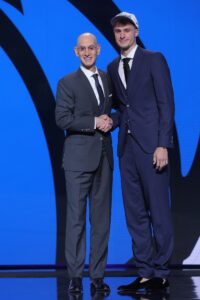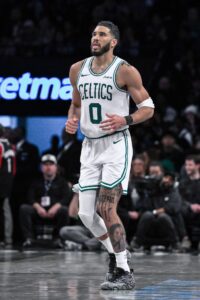The NBA has officially set the salary cap for its 2025/26 season. The cap has come in at $154,647,000, which was the projection all season long. It represents an increase of 10% on last season’s $140,588,000 cap.
Here are the details, courtesy of a league press release (Twitter link), ESPN’s Bobby Marks (Twitter link), and Eric Pincus of Bleacher Report (Twitter link):
- Salary cap: $154,647,000
- Luxury tax line: $187,895,000
- First tax apron: $195,945,000
- Second tax apron: $207,824,000
- Minimum salary floor: $139,182,000
- Non-taxpayer mid-level exception: $14,104,000
- Taxpayer mid-level exception: $5,685,000
- Room exception: $8,781,000
- Bi-annual exception: $5,134,000
- Maximum salaries:
- 6 years or fewer: $38,661,750
- 7-9 years: $46,394,100
- 10+ years: $54,126,450
- Early Bird exception: $13,936,650
- Estimated average salary: $13,870,000
- Trade cash limit: $7,964,000
- Maximum Exhibit 10 bonus: $85,300
- Expanded traded player exception amount: $8,527,000
The first tax apron for the 2025/26 league year ($195,945,000) will be the hard cap for any team that acquires a player via sign-and-trade, signs a player using more than the taxpayer portion of the mid-level exception, signs or acquires a player using a bi-annual exception, uses any portion of its mid-level exception to add a player via trade or waiver claim, uses an expanded traded player exception (ie. takes back more than 100% of a player’s salary using salary-matching), uses a trade exception generated prior to the start of the 2025 offseason, or signs a player who is waived during the regular season and had a salary exceeding $14,104,000.
The second tax apron ($207,824,000) represents the hard cap for a team that uses any portion of the mid-level exception, aggregates two or more player salaries in a trade, sends out cash in a trade, or uses a signed-and-traded player to take back salary.
The salary floor ($139,182,000) is the minimum amount a team must pay its players in 2025/26. A team that doesn’t spend up to that amount by the start of the regular season will pay the shortfall to the NBA and won’t be eligible for its full share of the luxury tax distribution at season’s end.
[RELATED: NBA Maximum Salaries For 2025/26]
[RELATED: Values Of 2025/26 Mid-Level, Bi-Annual Exceptions]
The trade cash limit is the maximum amount of money a team can send or receive during the 2025/26 league year. The sent and received categories are separate, so if a team sends out $7,240,000 in one trade and receives $7,240,000 in another, they aren’t back at square one — they’ve reached both limits.
The Early Bird amount represents the maximum starting salary a team can offer a player it intends to re-sign using his Early Bird rights, assuming that amount is greater than 175% of his previous salary.
Players earning below the estimated average salary in 2025/26 who are eligible for a veteran extension can receive a starting salary of up to 140% of the estimated average salary on a new deal. So the maximum starting salary for a player earning below the league average who signs an extension that begins in 2026/27 will be $19,418,000.
The maximum Exhibit 10 bonus is, as its name suggests, the highest possible bonus available to a player who signs an Exhibit 10 contract with an NBA team, gets cut, then spends at least 60 days with that club’s G League affiliate.
This amount ($85,300) is also the maximum two-way protection amount, which means a player who signs a two-way contract before the season can get up to $85,300 guaranteed upon signing. A player who signs a contract with more than $85,300 guaranteed is not subsequently eligible for a two-way contract with that team in 2025/26.
The expanded traded player exception amount ($8,527,000) is the amount of excess salary a team operating under both tax aprons is permitted to take back in a simultaneous trade, assuming that amount plus the player’s (or players’) outgoing salary is: (A) less than 200% (plus $250K) of the outgoing salary; and (B) more than 125% (plus $250K) of the outgoing salary. For instance, a non-apron team trading a player with a $10MM cap hit could legally acquire a player earning $18,527,000. We have more information on this rule in our traded player exception glossary entry.
The NBA is projecting its salary cap to rise by 7% in 2026/27, tweets Marks. Most salary projections for contracts signed in ’26/27 and beyond had assumed annual 10% cap increases, so it’s notable that the first official estimate from the league is coming in a little lower than that.
 In each NBA league year, rookie scale amounts are assigned to each first-round slot, from No. 1 through No. 30. Teams can sign their first-rounders to as little as 80% of that rookie scale amount, or up to 120% of that figure.
In each NBA league year, rookie scale amounts are assigned to each first-round slot, from No. 1 through No. 30. Teams can sign their first-rounders to as little as 80% of that rookie scale amount, or up to 120% of that figure. The first chart shows the maximum salaries for a player re-signing with his own team — a player’s previous team can offer five years instead of four, and 8% annual raises instead of 5% raises. The second chart shows the maximum salaries for a player signing with a new team.
The first chart shows the maximum salaries for a player re-signing with his own team — a player’s previous team can offer five years instead of four, and 8% annual raises instead of 5% raises. The second chart shows the maximum salaries for a player signing with a new team.